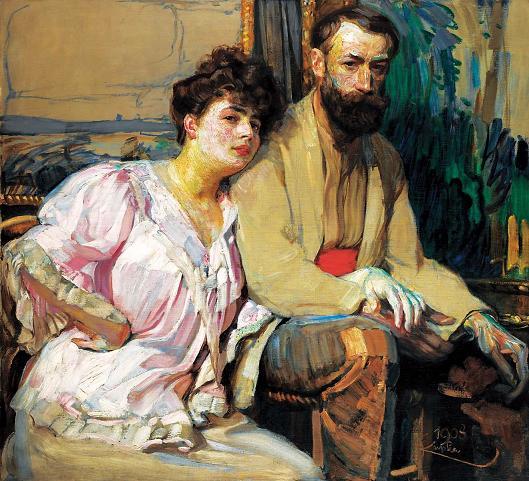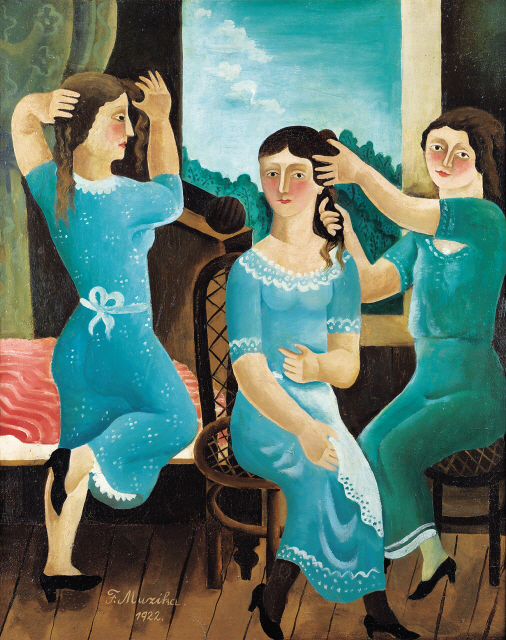Czech modern art on view for first time in Korea
Paintings by 28 Czech artists summarize history of Czech modern art
By Lee Woo-youngPublished : Jan. 27, 2013 - 19:11
The art of the Czech Republic is less well known than its literature or music, but the National Museum of Contemporary Art, Korea and the National Gallery in Prague have worked together to break the mold and brought a selection of 107 paintings by 28 modern Czech artists for an exhibition in Korea.
“Korean museums often hold so-called ‘blockbuster’ exhibitions focusing on mainstream art of Western Europe in order to draw large a number of visitors. But as a national museum of Korea with a responsibility to introduce various art movements, we are presenting a great selection of Czech modern paintings to the Korean audience,” said Choi Eun-ju, the chief curator of the NMOCA, at the press conference on Thursday.
Unlike some Czech writers and musicians such as Franz Kafka and Milan Kundera and Antonin Dvorak and Bedrich Smetan, Czech artists are little-known outside the art world.
“We brought here great selections of Czech modern art. The paintings reach top prices of art market not only by Czech connoisseurs, but also in international art auctions,” said Vladimir Rosel, general director of the National Gallery in Prague.
“The exhibition presents the flow from symbolism, expressionism, cubism, abstract art to Surrealism until the end of World War II,” said Rosel, noting that the artists featured in the exhibition left impressive footprints in Western art history as well.
The exhibition titled “Memory of Landscape I Have Never Seen,” highlights the transformation of Czech modern art from the late 19th century to the early 20th century.
The exhibition begins with the period where Czech artists adopted modern art trends and styles from 1905-1917. It started with the sensational exhibition of Norwegian artist Edvard Munch, who led young Czech artists to adopt modern expressionism.
In the meantime, artists influenced by popular Western European art began to establish independent styles in search of their identity as Czech.
The attempt witnessed the birth of Czech Cubism in 1910s, which was considered an innovative style different from the French cubism in terms of color and narrative. It also began the movement of abstract art in the country. Paintings of Frantisek Kupka and Emil Filla, considered the most representative figure in Czech modern art, show their attempt to adopt new techniques and styles.
“Korean museums often hold so-called ‘blockbuster’ exhibitions focusing on mainstream art of Western Europe in order to draw large a number of visitors. But as a national museum of Korea with a responsibility to introduce various art movements, we are presenting a great selection of Czech modern paintings to the Korean audience,” said Choi Eun-ju, the chief curator of the NMOCA, at the press conference on Thursday.
Unlike some Czech writers and musicians such as Franz Kafka and Milan Kundera and Antonin Dvorak and Bedrich Smetan, Czech artists are little-known outside the art world.
“We brought here great selections of Czech modern art. The paintings reach top prices of art market not only by Czech connoisseurs, but also in international art auctions,” said Vladimir Rosel, general director of the National Gallery in Prague.
“The exhibition presents the flow from symbolism, expressionism, cubism, abstract art to Surrealism until the end of World War II,” said Rosel, noting that the artists featured in the exhibition left impressive footprints in Western art history as well.
The exhibition titled “Memory of Landscape I Have Never Seen,” highlights the transformation of Czech modern art from the late 19th century to the early 20th century.
The exhibition begins with the period where Czech artists adopted modern art trends and styles from 1905-1917. It started with the sensational exhibition of Norwegian artist Edvard Munch, who led young Czech artists to adopt modern expressionism.
In the meantime, artists influenced by popular Western European art began to establish independent styles in search of their identity as Czech.
The attempt witnessed the birth of Czech Cubism in 1910s, which was considered an innovative style different from the French cubism in terms of color and narrative. It also began the movement of abstract art in the country. Paintings of Frantisek Kupka and Emil Filla, considered the most representative figure in Czech modern art, show their attempt to adopt new techniques and styles.

Kupka’s exploration of various art movements are shown in some of his major paintings such as “Portrait of F. Kupka and Mrs. E. Kupkova” and his self-portrait as well as abstract paintings of “Insistent White Line” and “Variation on the Blowing Blue.”
According to Rosel, it was a cultural golden era with active exchanges between the Czech area and others, making the country a true “melting pot of the Western culture” in the early 20th century.
He said about half of people in Prague spoke German and one-third of the population was German. And still the city has large Italian, French and German communities.
The exhibition also looks at changes brought to Czech art at the end of World War I and the independence of Czechoslovakia from Austrian rule (1918-30).
“This is when social subjects started to appear in Czech fine arts,” said Liu Jienne.
“Czech’s experience is not so different from Asian countries such as Korea in terms of its small and large scale wars, disputes and conflicts in history as well as the process of independence,” she explained.
Artists sought new forms of art and answers to its function in the rapidly changing social environment, which eventually brought the emergence of avant-garde and surrealistic paintings.
“Portrait of an Old Woman” by Miloslav Holy is considered as a frank depiction of people based on the socialist realism.

On the other hand, some artists paid attention to landscape or nude paintings. “Three Sisters” by Frantisek Muzika look like they are part of illustrations in novels as many artists at the time worked in different fields from stage design to filmmaking.
The third part of the exhibition focuses on the time when Czech art established firm characteristics as a result of artists’ effort to differentiate from Western Europe and attempt to fight against the totalitarian regime during the World War II.
Josef Sima’s “Memory of Landscape I Have Never Seen,” from which the exhibition is entitled, shows the dominant surrealistic movement the artists chose as a way to express social and political situation.
The exhibition “Memory of Landscape I have Never Seen: Collections from National Gallery in Prague” continues through April 21 at Deoksugung Museum of the National Museum of Contemporary Art, Korea. English guided tours are provided on Saturdays at 2:30 p.m. The exhibition closes on Mondays. For more information, call (02) 6273-4242.
By Lee Woo-young (wylee@heraldcorp.com)




![[Herald Interview] 'Amid aging population, Korea to invite more young professionals from overseas'](http://res.heraldm.com/phpwas/restmb_idxmake.php?idx=644&simg=/content/image/2024/04/24/20240424050844_0.jpg&u=20240424200058)











![[KH Explains] Korean shipbuilding stocks rally: Real growth or bubble?](http://res.heraldm.com/phpwas/restmb_idxmake.php?idx=652&simg=/content/image/2024/04/25/20240425050656_0.jpg&u=)

